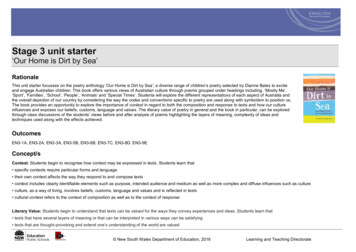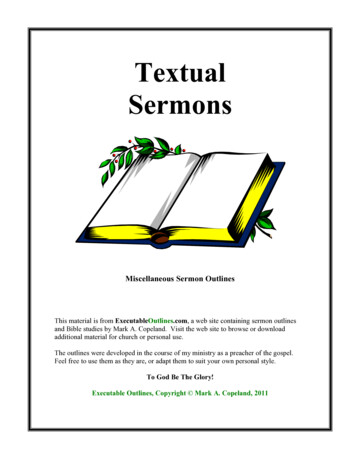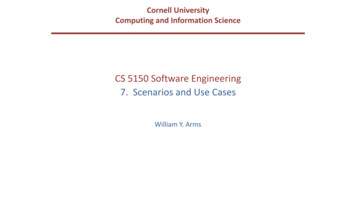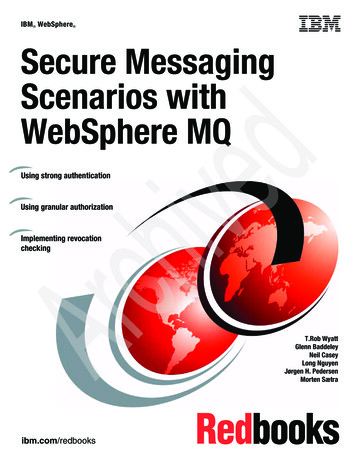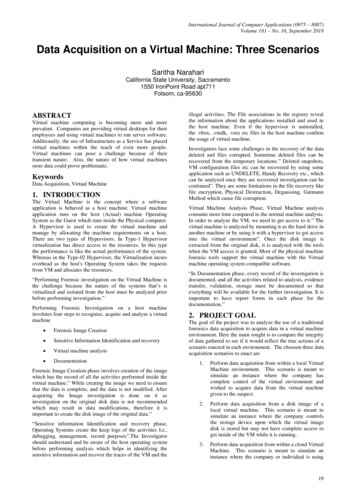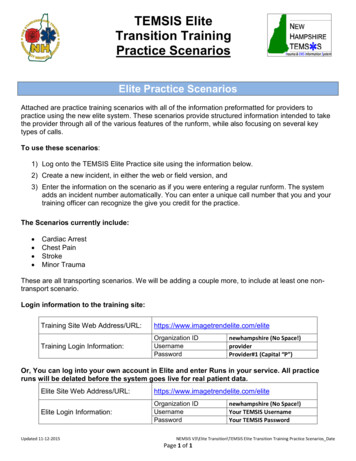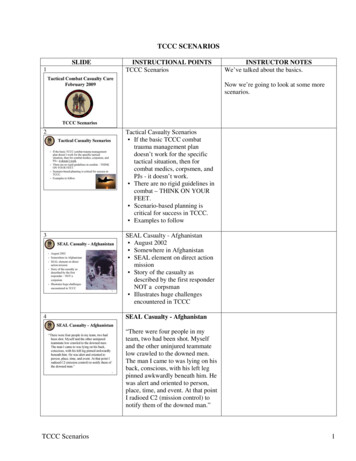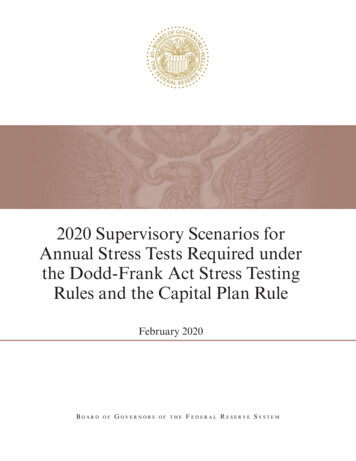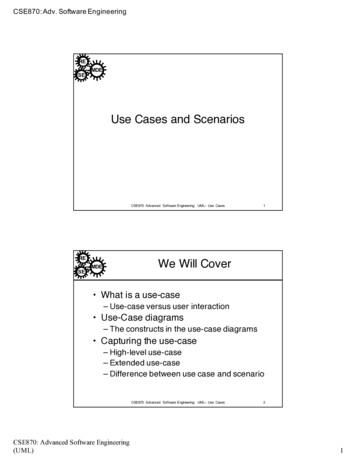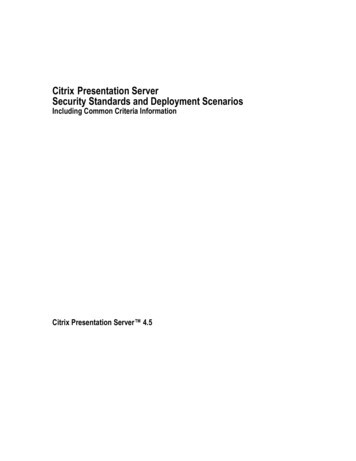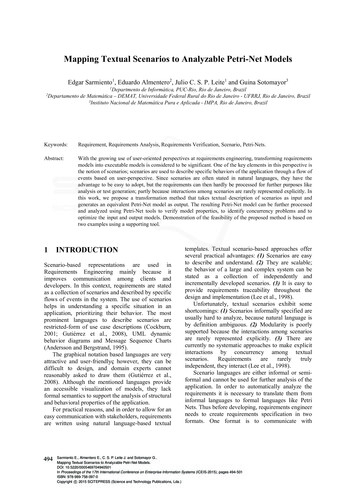
Transcription
Mapping Textual Scenarios to Analyzable Petri-Net ModelsEdgar Sarmiento1, Eduardo Almentero2, Julio C. S. P. Leite1 and Guina Sotomayor32Departamento1Departmento de Informática, PUC-Rio, Rio de Janeiro, Brazilde Matemática – DEMAT, Universidade Federal Rural do Rio de Janeiro - UFRRJ, Rio de Janeiro, Brazil3Instituto Nacional de Matemática Pura e Aplicada - IMPA, Rio de Janeiro, BrazilKeywords:Requirement, Requirements Analysis, Requirements Verification, Scenario, Petri-Nets.Abstract:With the growing use of user-oriented perspectives at requirements engineering, transforming requirementsmodels into executable models is considered to be significant. One of the key elements in this perspective isthe notion of scenarios; scenarios are used to describe specific behaviors of the application through a flow ofevents based on user-perspective. Since scenarios are often stated in natural languages, they have theadvantage to be easy to adopt, but the requirements can then hardly be processed for further purposes likeanalysis or test generation; partly because interactions among scenarios are rarely represented explicitly. Inthis work, we propose a transformation method that takes textual description of scenarios as input andgenerates an equivalent Petri-Net model as output. The resulting Petri-Net model can be further processedand analyzed using Petri-Net tools to verify model properties, to identify concurrency problems and tooptimize the input and output models. Demonstration of the feasibility of the proposed method is based ontwo examples using a supporting tool.1INTRODUCTIONScenario-based representations are used inRequirements Engineering mainly because itimproves communication among clients anddevelopers. In this context, requirements are statedas a collection of scenarios and described by specificflows of events in the system. The use of scenarioshelps in understanding a specific situation in anapplication, prioritizing their behavior. The mostprominent languages to describe scenarios arerestricted-form of use case descriptions (Cockburn,2001; Gutiérrez et al., 2008), UML dynamicbehavior diagrams and Message Sequence Charts(Andersson and Bergstrand, 1995).The graphical notation based languages are veryattractive and user-friendlyç however, they can bedifficult to design, and domain experts cannotreasonably asked to draw them (Gutiérrez et al.,2008). Although the mentioned languages providean accessible visualization of models, they lackformal semantics to support the analysis of structuraland behavioral properties of the application.For practical reasons, and in order to allow for aneasy communication with stakeholders, requirementsare written using natural language-based textual494templates. Textual scenario-based approaches offerseveral practical advantages: (1) Scenarios are easyto describe and understand. (2) They are scalable;the behavior of a large and complex system can bestated as a collection of independently andincrementally developed scenarios. (3) It is easy toprovide requirements traceability throughout thedesign and implementation (Lee et al., 1998).Unfortunately, textual scenarios exhibit someshortcomings: (1) Scenarios informally specified areusually hard to analyze, because natural language isby definition ambiguous. (2) Modularity is poorlysupported because the interactions among scenariosare rarely represented explicitly. (3) There arecurrently no systematic approaches to make explicitinteractions by concurrency among dent, they interact (Lee et al., 1998).Scenario languages are either informal or semiformal and cannot be used for further analysis of theapplication. In order to automatically analyze therequirements it is necessary to translate them frominformal languages to formal languages like PetriNets. Thus before developing, requirements engineerneeds to create requirements specification in twoformats. One format is to communicate withSarmiento E., Almentero E., C. S. P. Leite J. and Sotomayor G.Mapping Textual Scenarios to Analyzable Petri-Net Models.DOI: 10.5220/0005469704940501In Proceedings of the 17th International Conference on Enterprise Information Systems (ICEIS-2015), pages 494-501ISBN: 978-989-758-097-0Copyright c 2015 SCITEPRESS (Science and Technology Publications, Lda.)
Mapping Textual Scenarios to Analyzable Petri-Net Modelscustomers (textual scenarios) and other format is foranalysis or testing (Petri-Nets).The original contribution of this work is anautomated transformation method that takes textualdescription of scenarios (conform to a metamodeldefined in this work) as input and generates anequivalent Petri-Net model (conform to a restrictedPetri-Net metamodel) as output. The generation isperformed by a model transformation, defined asmapping rules and implemented in the C&L (C&L,2014) prototype tool. It might eliminate theredundancy of writing specification twice.This transformation allows to benefit both fromgraphical and textual scenario advantages, and itallows an easier integration to available Petri-Nettools (PIPE2, 2014). On the basis of thistransformation, it is possible: (1) Analyze someproperties of the executable model, i.e. to verifywhether the scenario is consistent, complete andcorrect. (2) Identify concurrency problems such asdeadlocks among concurrent scenarios that competewith each other for common resources. (3) Use thePetri-Net for further treatments like test generation.The details of our proposal are presented in 6Sections, from the related work, the description ofthe source and target metamodels, the strategy wepropose, to the case study and conclusions.2RELATED WORKMany researches have shown the importance toformalize the informal aspects of scenarios in orderto be useful in automated analysis. Some researchesfocused on developing the formal semantics forscenario representations, recent researches focus ondeveloping techniques to transform scenarios intoexecutable models with rigorous semantics.Hsia et al., (1994) used a BNF-like grammar toformally describe scenarios. Scenarios arerepresented like scenario trees and scenario schema.A tree is constructed to represent all the scenariosfor a particular user view. While scenario trees aredefined, each of scenarios is converted into anequivalent regular grammar. This approach is onlyeffective when applied to a small number ofrelatively simple scenarios (Lee et al., 2001).UML Sequence Diagrams (Lee et al., 2001) andMessage Sequence Charts - MSCs (Andersson andBergstrand, 1995) are frequently used as formalismsfor scenarios. The main problem tackled by theseapproaches is the interactions among scenarios, andthese have advantages over the grammar-basedapproach in terms of scalability/understandability.However, these models are either informal or semiformal and can not be used for automated analysis.In our work, we describe scenarios using arestricted form of the natural language; then,scenarios are transformed into Petri-Nets, which areused as the mechanism to enable the analysis. Otherapproaches based on natural language include (Leeet al., 1998; Somé, 2007; Zhao and Duan, 2009).In (Lee et al., 1998), is proposed a systematicprocedure to convert use case descriptions intoConstraint-based Modular Petri-net models, and toanalyze use cases. To facilitate the transformation,use cases are described in relation to formaldefinition of pre and post-conditions (like ActionCondition tables). Use cases are considered as acollection of interacting and concurrently executingunits of functionalities. However, intermediatemodels are created and alternative/exception flowsof use cases are not considered.In (Somé, 2007), is proposed a semantics for usecases based on Petri-Nets. However, the syntax todescribe use cases does not deal with non-sequentialrelationships (concurrency) and only deals withsequential relationships (include and extend).In (Zhao and Duan, 2009), is proposed anapproach to formalize use cases with Petri-Nets. Asemi-formal language is proposed for use casesyntax. This syntax is based on message sender andreceiver objects, and the events in use cases can besequential, selection, iteration and concurrent. PetriNets are derived extracting objects and messagesbetween objects. However, it is necessary to create“event frames” for the extraction of the objects andthe message from each one the sentence events.The related Petri-Net based approaches exhibitthe following shortcoming: (1) Scenarios aredescribed in relation to formal definition of pre andpost-conditions. (2) There is a lack of systematicprocedures on how to represent the given scenarios.(3) The transformation of scenarios to Petri-Nets isnot automated (intermediate models). (4) Scenariosdo not provide constructs to support modularity.On opposite, our approach: (1) Use a semistructured natural language to write scenarios. (2)Define an abstract and concrete syntax for scenarios.(3) Implement automated mapping rules. (4) Providepowerful characteristics to deal with modularity andidentify concurrency problems.3BACKGROUDThe natural language representation of scenarios isbased on a previous work where were defined an495
ICEIS 2015 - 17th International Conference on Enterprise Information Systemsabstract syntax (metamodel) and a concrete syntax(restricted form of natural language) for scenarios(leite et al., 2000). Differently to previous work, inthis work our focus is the transformation ofscenarios to executable models.For furtherpurposes like analysis or test generation, the syntaxwas updated: the result attribute (or expected result)was added to the scenario syntax.3.1ScenarioScenario is a language used to help theunderstanding of the requirements of the application;it is easy to understand by the developers and otherstakeholders. Scenario represents a partialdescription of the application behavior that occurs ata given moment in a specific geographical context a situation (Leite et al., 2000).In this work, the scenario modelling is based on asemi-structured natural language proposed by Leiteet al., (2000), and it is composed of the entitiesdescribed in Table 1.Use case (Cockburn, 2001) is a particular modelof scenario. Use cases describe the interactionbetween the users and the system through itsinterface. Scenarios describe: (1) situations in theenvironment and the system, (2) interactions amongobjects or modules and (3) procedures or methods.Table 1 explains how a scenario (Leite et al., 2000)can be also used as a use case (Cockburn, 2001).Table 1: Comparing scenario and use case.ScenarioDescriptionUse CaseTitleIdentifies the scenario. Must be unique.Use Case #GoalDescribe the purpose of the scenario.Goal In ContextScopeDescribes the scenario initial state.Context Must be described through at least one of these options:Levelpre-condition, geographical or temporal location.PreconditionsPassive entities used by the scenario to achieve its goal.ResourcesTriggerResources must appear in at least one of the episodes.Active entities directly involved with the situation.ActorsActorsActors must appear in at least one of the episodes.Sequential sentences in chronological order with theEpisodesDescriptionparticipation of actors and use of resources.ExtensionsSituations that prevent the proper course of the scenario.ExceptionIts treatment should be described.Sub-VariationsNon-functional aspects that qualify/restrict the qualityConstraint with witch the goal is achieved. These aspects areapplied to the context, resources or episodes.Internal condition satisfied by an episode/exception, andResult described as a message or information of the state ofsome resource.Figure 1 shows a metamodel for scenariodescription used in this work. It defines an abstractsyntax for a scenario using a class diagram.Definition 1: According to our metamodel, ascenario is a 7-tuple S (Title, Goal, Context,Resources, Actors, Episodes and Exceptions) and theattributes Constraint and Result.A scenario S must satisfy a goal that is reached496by performing its episodes. The episodes describethe operational behavior of the situation, whichincludes the main course of action and possiblealternatives. An exception can arise during theexecution of episodes, and indicates that there is anobstacle to satisfy the goal. The treatment to thisexception does not need to satisfy the scenario goal.Figure 1: Scenario metamodel.The episodes of a scenario can be of threedifferent types: simple, conditional and optional.Simple episodes are those necessary to complete thescenario; Conditional episodes are those whoseoccurrence depends on internal or externalcondition, internal conditions can come aints or previous episodes; Optional episodesare those that may or may not take place dependingon conditions that cannot be detailed.A sequence of episodes implies a precedenceorder, but a non-sequential order can be bounded bythe symbol “#”. This is used to describe parallel orconcurrent episodes (# Episode Series #).The scenario language makes explicit thesequential interactions among scenarios. Scenarioscan be connected to other scenarios through links,yielding a complex network of relationships:Integration Scenario gives an overview of therelationship among several scenarios of theapplication, since each integration scenario episodecorresponds to a scenario.Sub-scenario is defined when an episode of ascenario can be described by another scenario. Thisallows the decomposition of complex scenarios,facilitating both its writing and understanding.Pre-condition is a relationship defined within thecontext element of a scenario. A scenario that is precondition to other must be executed first and so on.Exception relationship is defined when a scenario isused to detail the exceptional behavior of another.The main scenario should be executed and an
Mapping Textual Scenarios to Analyzable Petri-Net Modelsexception must occur to
For practical reasons, and in order to allow for an easy communication with stakeholders, requirements are written using natural language-based textual templates. Textual scenario-based approaches offer several practical advantages: (1) Scenarios are easy to describe and understand. (2) They are scalable; the behavior of a large and complex system can be stated as a collection of
